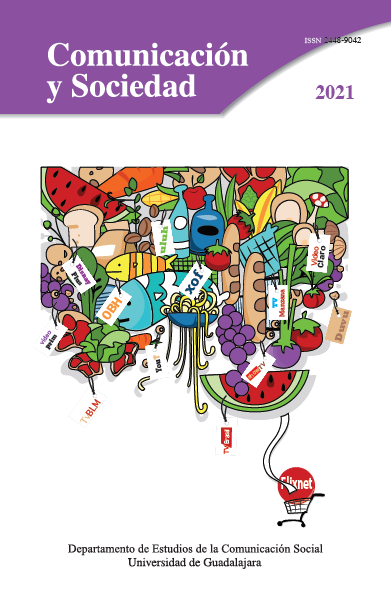De São Paulo a Seúl: las estrategias de Netflix en los mercados periféricos
DOI:
https://doi.org/10.32870/cys.v2021.8038Palabras clave:
Netflix, Flujo transnacional, Brasil, Corea del Sur, Periferias globalesResumen
Con el objetivo de examinar las estrategias implementadas por Netflix en su expansión global y partiendo de los debates sobre la transnacionalización de los flujos televisivos, nos propusimos observar la presencia de esta plataforma en dos mercados periféricos: Brasil y Corea del Sur. En ambos encontramos tácticas similares, como la concesión de licencias y encargos de contenido local, además de alianzas con productoras nacionales. Aunque identificamos un cambio reciente en las estrategias de la compañía desde América Latina hacia el mercado asiático, argumentamos que se hace imperativo deconstruir la tiene espacio más grande arriba de esta línea.Descargas
Citas
Albuquerque, A. (2019). Protecting democracy or conspiring against it? Media and politics in Latin America: A glimpse from Brazil. Journalism, 20(7), 906-923. https://doi.org/10.1177%2F1464884917738376
Albuquerque, A., Quinan, R., Meimaridis, M. (2021). The Mechanism and the fictional mediatization of Operation Car Wash. Questões Transversais, 8(16), 58-64. http://revistas.unisinos.br/index.php/questoes/article/view/19584
Alvarado, A. B. U. (2004). As telenovelas mexicanas no México afuera. En M. I. V. Lopes (Org.), Telenovela: internacionalização e interculturalidade (pp. 139-168). Edições Loyola.
Baladron, M. & Rivero, E. (2019). Video-on-demand services in Latin America: Trends and challenges towards access, concentration and regulation. Journal of Digital Media & Policy, 10(1), 109-126. https://doi.org/10.1386/jdmp. 10.1.109_1
Brazil’s Supreme Court confirms that former judge Moro was biased in Lula trial. (22 de abril de 2021). The Rio Times. https://riotimesonline.com/brazil-news/brazil/brazils-supreme-court-confirms-that-former-judge-moro-was-biased-in-lula-trial/
Brzeski, P. (14 de abril de 2021). Netflix Reports South Korea Profit Jump in Rare Public Disclosure. The Hollywood Reporter. https://www.hollywoodreporter.com/news/netflix-reports-south-korea-profit-jump-in-rare-public-disclosure
Chalaby, J. K. (2005). Transnational television worldwide: Towards a new media order. Ib tauris.
Chong, Z. (10 de mayo de 2018). South Korea gets super-duper fast internet. CNET. https://www.cnet.com/news/south-korea-gets-super-duper-fast-internet/
Chua, B. H. & Iwabuchi, K. (Eds.). (2008). East Asian pop culture: Analysing the Korean wave (Vol. 1). Hong Kong University Press.
Cornelio-Marí, E. M. (2020). Mexican Melodrama in the Age of Netflix: Algorithms for Cultural Proximity. Comunicación y Sociedad, e7481. https://doi.org/10.32870/cys.v2020.7481
Dash, S. (21 de abril de 2021). Netflix co-founder Reed Hastings says India is a 'speculative' investment – talks about pricing experiments and partnership with Jio. Business Insider India. https://www.businessinsider.in/tech/news/netflix-co-founder-talks-about-pricing-experiments-in-india-and-partnership-with-jio/articleshow/82175848.cms
Dong, S. H. (14 de enero de 2021). Number of hallyu fans around the world surpasses 100 million. The Korea Times. https://www.koreatimes.co.kr/www/culture/2021/02/703_302463.html
Doo, R. (30 de junio de 2016). Netflix plans to expand presence in Korea. The Korea Herald. http://www.koreaherald.com/view.php?ud=20160630001006
Doyle, J. (14 de enero de 2019). ‘Netflix of Asia’ to take on US streaming giants like YouTube as Korea’s Oksusu and Pooq team up. South China Morning Post. https://www.scmp.com/week-asia/economics/article/2181578/screen-grab-korean-broadcasters-join-forces-fight-netflix
Ferreira, C. (14 de diciembre de 2020). Produtores audiovisuais querem regulamentacao de servico de streaming para proteger industria nacional. Câ mara dos deputados. https://www.camara.leg.br/noticias/715633-produtores-audiovisuais-querem-regulamentacao-de-servico-de-streaming-para-proteger-industria-nacional/
Hall, S. (1992). The West and the Rest: Discourse and power. En S. Hall & B. Gieben (Eds.), Formations of modernity (pp. 275-320). Polity Press; The Open University.
Jenner, M. (2018). Netflix and the Re-invention of Television. Springer.
Jin, D. Y. (2007). Reinterpretation of cultural imperialism: Emerging domestic market vs continuing US dominance. Media, Culture & Society, 29(5), 753-771. https://doi.org/10.1177/0163443707080535
Jin, D. Y. (2015). Digital Platforms, Imperialism and Political Culture. Routledge.
Jin, D. Y. & Yoon, K. (2014). The social mediascape of transnational Korean pop culture: Hallyu 2.0 as spreadable media practice. New Media & Society, 18(7), 1277-1292. https://doi.org/10.1177/1461444814554895
Joo, J. (2011). Transnationalization of Korean popular culture and the rise of “pop nationalism” in Korea. The Journal of Popular Culture, 44(3), 489-504. https://doi.org/10.1111/j.1540-5931.2011.00845.x
Ju, H. (2019). Korean TV drama viewership on Netflix: Transcultural affection, romance, and identities. Journal of International and Intercultural Communication, 13(1), 32-48. https://doi.org/10.1080/17513057.2019.1606269
Kim, B. W. (26 de noviembre de 2020). Netflix launches separate content office in Korea. The Korea Herald. http://www.koreaherald.com/view.php?ud=20201126000893
Kim, M. (24 de febrero de 2021). Riding the K-Wave, Netflix Spotlights Stories Made in Korea and Watched by the World. Netflix. https://about.netflix.com/en/news/riding-the-k-wave-netflix-spotlights-stories-made-in-korea-and-watched-by
Kim, M. S., Kim, E., Hwang, S., Kim, J. & Kim, S. (2016). Willingness to pay for over-the-top services in China and Korea. Telecommunications Policy, 41(3), 197-207. http://dx.doi.org/10.1016/j.telpol.2016.12.011
La Pastina, A. C. & Straubhaar, J. D. (2005). Multiple proximities between television genres and audiences: The schism between telenovelas’ global distribution and local consumption. International Communication Gazette, 67(3), 271-288. https://doi.org/10.1177/0016549205052231
Lee, Y. I. & Kim, H. J. (16 de abril de 2019). Netflix’s cheaper plan delivers another upset to Korea’s OTT market. Pulse. https://pulsenews.co.kr/view.php?year=2019&no=235160
Lim, J. W. (29 de noviembre de 2020). Netflix becomes major Hallyu medium. The Korea Herald. http://www.koreaherald.com/view.php?ud=20201129000105
Lobato, R. (2019). Netflix Nations: The Geography of Digital Distribution. NYU Press.
Lotz, A. D. (2020). In between the global and the local: Mapping the geographies of Netflix as a multinational service. International Journal of Cultural Studies, 24(2), 195-215. https://doi.org/10.1177/1367877920953166
Mazur, D. (2018). Um Mergulho na Onda Coreana, Nostalgia e Cultura Pop na Série de K-dramas “Reply” (Tesis de maestria). Universidade Federal Fluminense, Brasil. http://ppgcom.uff.br/daniela-de-souza-mazur-monteiro/
Meimaridis, M., Mazur, D. & Rios, D. (2020). The Streaming Wars in the Global Periphery: A Glimpse from Brazil. Series-International Journal of TV Serial Narratives, 6(1), 65-76. https://doi.org/10.6092/issn.2421-454X/10457
Moody, R. (20 de julio de 2020). Netflix subscribers and revenue by country. Comparitech. https://www.comparitech.com/tv-streaming/Netflix-subscribers/
Netflix. (6 de enero de 2016). Netflix Is Now Available Around the World. https://about.netflix.com/en/news/netflix-is-now-available-around-the-world
Netflix. (21 de noviembre de 2019). CJ ENM/Studio Dragon-Netflix announce a long-term partnership. https://about.Netflix.com/en/news/cj-enm-studio-dragon-Netflix-announce-a-long-term-partnership
Netflix. (6 de enero de 2021). Expanding Our Presence in Korea: Netflix Welcomes the New Year With Two New Production Facilities. https://about.netflix.com/en/news/expanding-our-presence-in-korea-netflix-production-facilities
Netflix, Inc. (19 de enero de 2021). Shareholder Letter. https://s22.q4cdn.com/959853165/files/doc_financials/2020/q4/FINAL-Q420-Shareholder-Letter.pdf
Park, G. Y. (22 de noviembre de 2019). CJ ENM, Netflix sign 3-year partnership deal. The Investor. https://www.theinvestor.co.kr/view.php?ud=20191122000513
Park, J. H. (6 de mayo de 2018). Netflix aims to have stronger presence in Korea. The Korea Times. https://www.koreatimes.co.kr/www/art/2018/05/688_248553.html
Pennafort, R. (15 de marzo de 2018). Brasil ja esta entre os tres principais mercados da Netflix. Estadão. https://cultura.estadao.com.br/noticias/televisao,brasil-ja-esta-entre-os-tres-principais-mercados-da-netflix,70002228916
Penner, T. A. & Straubhaar, J. (2020). Títulos originais e licenciados com exclusividade no catálogo brasileiro da Netflix. MATRIZes, 14(1), 125-149. https://doi.org/10.11606/issn.1982-8160.v14i1p125-149
Richter, A. (16 de abril de 2021). Supreme Court upholds decision annul Lula’s convictions. Agência Brasil. https://agenciabrasil.ebc.com.br/en/justica/noticia/2021-04/supreme-court-upholds-decision-annul-lulas-convictions
Riley, C. (18 de octubre de 2016). Netflix admits its plan for China has failed. CNN. https://money.cnn.com/2016/10/18/technology/netflix-china/
Robinson, M. J. (2017). Television on demand: Curatorial culture and the transformation of TV. Bloomsbury Publishing USA.
Ryoo, W. (2009). Globalization, or the logic of cultural hybridization: the case of the Korean wave. Asian Journal of Communication, 19(2), 137-151. https://doi.org/10.1080/01292980902826427
Sá, V. M. M. (2014). Práticas digitais, níveis de envolvimento e pirataria: Um estudo sobre a recepção e distribuição informal de seriados de televisão no Brasil. E-compós, 17(2), 1-18. https://doi.org/10.30962/ec.1030
Senna, E. (2021). Regulation of Producer Rights and Intellectual Property in the Age of Streaming. En S. Solot (Ed.), The Audiovisual Public Policy Landscape in Latin America (pp. 136-139). Latin American Training Center.
Seo, H. S. (15 de octubre de 2018). Media Industry Divided on Whether to Block or Promote Netflix. The Korea Bizwire. http://koreabizwire.com/media-industry-divided-on-whether-to-block-or-promote-Netflix/125968
Shalders, A. (27 de marzo de 2018). O que é verdade e o que é invenção em ‘O Mecanismo’, a série da Netflix sobre a Lava Jato. BBC News Brasil. https://www.bbc.com/portuguese/bra-sil-43550506
Shaw, L. (12 de enero de 2017). Netflix Wants the World to Binge-Watch. Bloomberg. https://www.bloomberg.com/news/features/2017-01-12/netflix-wants-the-world-to-binge-watch
Shaw, L. (31 de enero de 2020). Netflix moving Latin American base to Mexico as ambitions grow. Bloomberg. https://www.bloomberg.com/news/articles/2020-01-31/netflix-moving-latin-american-base-to-mexico-as-ambitions-grow
Shim, D. (2008). The growth of Korean cultural industries and the Korean wave. En B. C. Chua & K. Iwabuchi (Eds.), East Asian pop culture: Analysing the Korean wave (pp. 15-32). Hong Kong University Press.
Shim, W. H. (8 de septiembre de 2020). Korea reveals details of ‘Netflix law’. The Korea Herald. http://www.koreaherald.com/view.php?ud=20200908000943
Sinclair, J., Jacka, E. & Cunningham, S. (2000). Peripheral Vision. En F. J. Lechner & J. Boli (Eds.), The Globalization Reader (pp. 301-306). Blackwell.
Sohn, J. Y. (25 de enero de 2018). Netflix to push boundaries of Korean media content. The Korean Herald. http://www.koreaherald.com/view.php?ud=20180125000871
Straubhaar, J. D. (1984). Brazilian television: The decline of American influence. Communication Research, 11(2), 221-240. https://doi.org/10.1177/009365084011002006
Straubhaar, J. D. (1991). Beyond media imperialism: Assymetrical interdependence and cultural proximity. Critical Studies in Media Communication, 8(1), 39-59. https://doi.org/10.1080/15295039109366779
Suh, J. & Nam, J. (1° de diciembre de 2020). Netflix: the savior of new Korean content or chains around local production companies? Hankyoreh. http://english.hani.co.kr/arti/english_edition/e_entertainment/972341.html
Waisbord, S. (2004). McTV: Understanding the global popularity of television formats. Television & New Media, 5(4), 359-383. https://doi.org/10.1177/1527476404268922
Wallerstein, I. M. (2006). European universalism: The rhetoric of power. The New Press.
Yonhap. (12 de noviembre de 2019). Netflix estimated to have 2m users in S. Korea. The Korea Herald. http://www.koreaherald.com/view.php?ud=20191112000731
Zaverucha, V. (2021). Crisis, Asymmetry and Regulation. En S. Solot (Ed.), The Audiovisual Public Policy Landscape in Latin America (pp. 63-67). Latin American Training Center.
Descargas
Publicado
Cómo citar
Número
Sección
Licencia
Derechos de autor 2021 Melina Meimaridis, Daniela Mazur, Daniel Rios

Esta obra está bajo una licencia internacional Creative Commons Atribución-NoComercial 4.0.
Los autores/as que publiquen en esta revista aceptan las siguientes condiciones:
De acuerdo con la legislación de derechos de autor, los autores conservan los derechos de autoría y otorgan a Comunicación y Sociedad el derecho de primera comunicación pública de la obra. Comunicación y Sociedad no realiza cargos a los autores por enviar y procesar artículos para su publicación.
Los autores/as pueden realizar otros acuerdos contractuales independientes y adicionales para la distribución no exclusiva de la versión del artículo publicado en Comunicación y Sociedad (por ejemplo incluirlo en un repositorio institucional o publicarlo en un libro) siempre que indiquen claramente que el trabajo se publicó por primera vez en Comunicación y Sociedad.


























